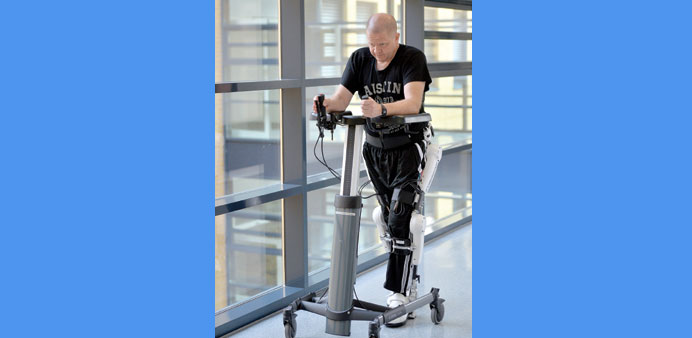SMALL STEPS: Robot-supported systems have until now been considered uncharted territory in the field of medical rehabilitation.
By Petra Buch
Dietbert Vogt has a physique as if carved from a piece of granite. At 1.85 metres, the steel construction worker used to work on building sites in any kind of weather. But in a matter of seconds in October 2013, his life was changed completely. A work accident made him a paraplegic — paralysed from the waist down — and confined to a wheelchair.
But now he is one of the first patients to be given treatment with a new technology a “robotic suit” — in the spinal cord treatment centre of the medical profession co-operative clinic of Bergmannstrost in the eastern German city of Halle. It’s a technology that looks like something out of a science fiction film.
Physiotherapist Michael Schleiff carefully puts the robotic suit on the 45-year-old patient. It is an unwieldy system of belts, supports, batteries, cables and computers that the patient wears on his back.
Along his legs, there is a moveable joint contraption that is bound to the ends of the feet. By remote control, specially-trained personnel can guide the motions of this robotic suit.
The system is called “Exoskeleton” and is completely new terrain in the field of medical rehabilitation. “It hasn’t been around for very long,” says Frank-Rainer Abel, head of the Paraplegic Medical Society. Till now, it has been used almost exclusively as a training system in clinics, but not to help the mobility of paraplegics.
“The robot system is unfortunately not suited for every patient,” says Klaus Roehl, the chief physician of the spinal column centre in Halle. Those people who are paralysed above the sixth vertebrae and so are unable to move their arms or sit upright, cannot be treated with it. In Halle, the experiments are aimed at producing a study about the uses, potential and limits of applying the exoskeleton technology.
One can see the tension in Dietbert Vogt’s expression in a recent test. His teeth are clenched as his physiotherapist helps him out of the wheelchair and holds him in an upright position. Vogt is using his arms to lean his entire body, along with the robotic suit, on a specially-constructed roller. His hands are grasping two handles.
Millimetre by millimetre, he slowly edges forward. At this rate, the hospital corridor of about 100 metres appears to be an endless expanse. Vogt’s physiotherapist is with him the entire way.
After 20 minutes, Vogts is completely spent, but jubilant. “It is totally exhausting. But when you are otherwise confined to a wheelchair, there are no words to describe it,” he says about his stroll. The broad-shouldered patient adds that he couldn’t manage any of this without the support of his family.
According to the Paraplegic Affairs Society, there are more than 100,000 paraplegics in Germany. Abel says there are 23 centres, including 11 like the one in Bergmannstrost that have a clinic specialized in trauma injuries. Starting some three months ago the robotic suit technology that comes from the United States and Japan began being tested in Halle. Exoskeletons are also being used for therapeutic purposes in Greifswald, Bochum, Murnau and Tuebingen.
“But in terms of the depth and breadth of our testing, we are the leader worldwide,” says head physician Roehl. Each year 1,100 patients are treated in his clinic, including 120 with severe paralysis. Dietbert Vogt, during his therapy lasting months in the clinic, has no illusions about his situation. He knows that his life will never be the same as it was before his accident.
“The robotic suits cannot replace a wheelchair,” concedes spinal column expert Roehl. “But they are a large step forward in the rehabilitation of patients.” His colleague Frank Roehrich nods in agreement. The neurosurgeon himself has been paralysed from the waist down after an accident 18 years ago. The robotic systems had nothing to do with normal walking, Roehrich says. “But the hope remains that the technology will one day be so advanced that one can maintain one’s balance without outside help, that the arms can move freely and that one can climb stairs.”
Roehrich is also undergoing therapy sessions in an exoskeleton suit.
“It is an indescribably beautiful feeling, at least for one brief moment to be able stand up and look at the other person at eye level,” he says. Then he heads to work in the usual manner — in a wheelchair. — DPA



